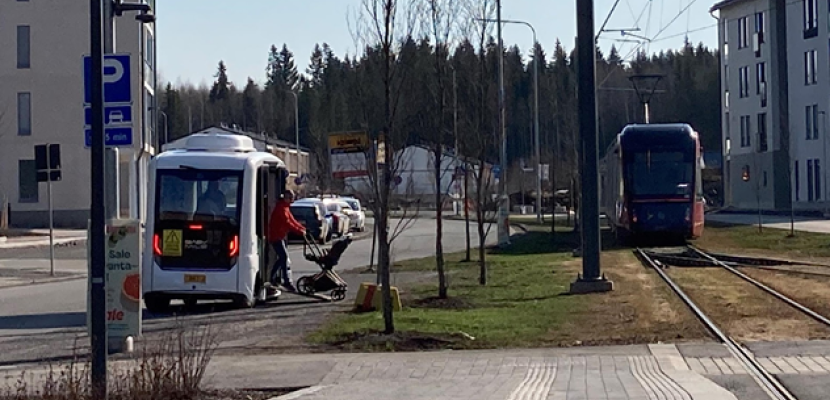
Intermodal connectivity using AV shuttles in Tampere, Finland

About this good practice
The City of Tampere developed an innovative practice integrating autonomous shuttles with public transport as last-mile service particularly in severe weather. Launched in January 2020, in this practice Tram 3 serves Hervanta by linking the university & shopping area in suburb center to rest of Tampere. Autonomous shuttles act as feeder service for convenient travel to Hervanta center from residential areas. Two routes were operated: Route 1 with one EasyMile AV shuttle bus running every 20 minutes between residential areas of Lintuhytti & Hervantajärvi (Tram 3’s first & last stop); & Route 2 with two Auve Tech AV shuttle buses running every 25 minutes, connecting residential areas around Hervantakeskus to the tram stop, university, & shopping area in suburb center. These shuttles operated daily from 7 am to 5 pm from January to June 2023, free of cost. Tests were conducted in a real-world environment with regular & rush hour traffic, varying weather conditions, on two-lane suburban streets shared with trams, & with speed limit of 30 km/h. The area includes intersections with tram traffic lights before roundabouts to prioritize trams & ensure safety. Even when vehicles were parked outside designated parking zones on roadsides, the shuttle buses operated safely. The City of Tampere, as a public authority, played a vital role in advancing smart mobility solutions through policy development, infrastructure investment, testbed management, international collaboration, & monitoring
Resources needed
Financial Resources: Materials & Services 7,508,776€; Depreciation 2,446,619€; Personnel 17,806,472€
Human Resources: OEM, Transport Operators, Tier1 Suppliers, Telecom Operators, Tech Providers, SMEs, Research & Academia, Passengers, Umbrella Associations, Road Operators, Authorities, Policy Makers
Evidence of success
Tampere's AV service testing showed a mean acceptance score of 6.80, with usefulness rated highest (mean = 8) and satisfaction lowest (mean = 6). Urban residents tended to rate lower. Accessibility Working Group emphasized accessibility challenges and discomfort, suggesting improvements like easy access, proper lighting, vocal information, and smooth driving. Recommendations include prioritizing practicality over luxury and city-wide deployment.
Potential for learning or transfer
This innovative practice integrates autonomous shuttle buses with public transport, providing crucial connections and last-mile options, particularly in severe weather conditions. Integrating shared automated mobility in Sustainable Urban Mobility Plans (SUMPs) compels authorities to incorporate automation into local planning, ensuring integration of modes, spatial areas, cooperation, public involvement, and monitoring. In Tampere, challenges arise from extreme cold and snowy conditions, requiring specialized route maintenance, including plowing, and addressing LiDAR obstructions. Unique parking regulations necessitate alternate-day route trajectories. These challenges are being overcome by conducting simulation tests to give input to the final system and route settings. Therefore, as technology advances, integrating automation into mobility planning becomes increasingly vital for permanent, scalable services.
Further information
Website
Good practice owner
You can contact the good practice owner below for more detailed information.